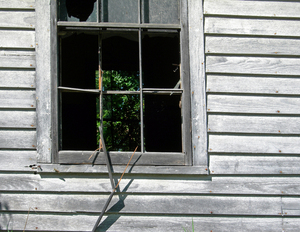About seven years ago, the company that I worked for had the windows all replaced in the building. The contractors who did the job told me that they were just going to throw away all of the old windows, so it would be okay for me to take them if I wanted them. They also showed me how to replace the glass if one broke. It was much easier than I’d ever imagined, and I took the old windows and painted bright colors on their glass.
When I was done, I wrapped them in Christmas lights and hung them on the walls. If you need to replace a pane of glass in a window in your home, or if you have decorative ideas for an old window pane, being able to replace the glass yourself can save you a good bit of money in the future. Follow these easy steps.
You can use regular glass for interior windows and doors usually, but for storm windows you will need to use tempered glass.
It is much easier to replace a window when the casing for the window is lying flat on your work surface and is clamped down, caulked side of window facing up.. In order to make this happen, you must remove the window from the casing if possible; take the door with the broken window off the hinges. If this isn’t possible, you can replace the glass in place, but if you do this it is wise to make sure you have a solid footing and are at eye level with the upper third of the pane.
Protective gloves are very important so that you don’t cut yourself if you have any type of accident. Making sure you have on protective gloves, remove the broken glass and put it in some kind of a trash receptacle that you can later tape up and clearly mark as “Broken Glass” when all the glass is out of the window. This is very important that you do this in order to prevent someone who may be digging through garbage cans to find aluminum cans or other tossed treasures.
It is also very important that you remove any remaining old caulk with a putty knife. It is helpful, but not necessary to use a heat gun to heat up the old caulk to get it all very loose. Also remove and save any of the old glazier’s points from the broken pane; it’s a good idea to save them in case they’re a different size than modern points. Use the metal brush to get the surface as clean as possible.
Measure the space that the glass will fill. Place the tape measure inside the frame for the window and be certain that your measurements are accurate. Measure at top and bottom to see if the window is plumb. If the shape of the window isn’t square or rectangular, make a template of paper. You should be measuring the opening for the glass, not the visual opening. There’s a shelf type area where the glass will lay, and that is what you should be measuring.
Go to your favorite hardware or glass store and order the cut of glass. The replacement glass should fit on the “shelf” from side to side and top to bottom fairly snugly, but to allow for expansion and contraction, have the glass cut up to 1/8″ smaller on the top and one side.
Again wearing protective gloves, insert the glass into the frame. For wood frames you should have the frame secured and steady and the glass at an angle. Like this, carefully set the edge on the side shelves and slide the whole pane slowly toward the top. When you’re just about there, carefully lay the glass almost flat, and then guide it as you slide it into the groove at the top of the window.
Replace the old glazier’s points where they were, and put in new ones unless you have to use the old ones because they are a kind that is no longer sold in hardware stores.
Scoop out a lump of glazing compound about the size of a baseball, and roll it around in your hands until it is soft and warmed up. Depending on the size of the window, you may have to replenish the supply in your hand more than once.
Scoop off a section of putty from your hand and spread it into the shelf at any point using the tip of the glazier’s tool or putty knife. Holding the knife or tool at an angle, smooth the putty along the shelf. Be sure that the putty doesn’t show from the other side of the window, and to do that you should see that the width of your putty isn’t greater than the shelf width. Continue spreading and smoothing until all of the sides are covered.
Corners can be tricky. Because rain water will slide down the window and the caulking will guide the water away from the glass, you want the corners to be mitered, but smoothly mitered.
Once you’ve finished caulking the window, allow it to cure at least a day before cleaning up any spillage on the glass. You’ll need to wait up to a week for the putty to cure enough to hold paint.
Admire your handywork and think of all the money you’ve saved from doing it yourself!
Optional step: carefully brush linseed oil on the surfaces that will be holding the caulk. This extends the life of your caulk job, but it takes a day or more to dry, so plan accordingly.








